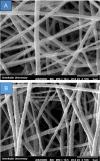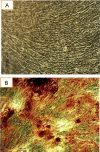Osteogenic differentiation of mesenchymal stem cells cultured on PLLA scaffold coated with Wharton's Jelly
- PMID: 28827995
- PMCID: PMC5547391
- DOI: 10.17179/excli2016-741
Osteogenic differentiation of mesenchymal stem cells cultured on PLLA scaffold coated with Wharton's Jelly
Abstract
Poly-L-lactic acid (PLLA) electrospun nanofiber scaffold is one of the most commonly used synthetic polymer scaffolds for bone tissue engineering application. However, PLLA is hydrophobic in nature, hence does not maintain proper cell adhesion and tissue formation, moreover, it cannot provide the osteo-inductive environment due to inappropriate surface characteristic and the lack of surface motives participating in the first cellular events. To modify these shortcomings different approaches have been used, among those the most commonly used one is coating of the surface of the electrospun nanofiber with natural materials. In this work Wharton's jelly (WJ), a tissue which surrounds the umbilical cord vessels, reaches in high amounts of extracellular matrix (ECM) components mainly; collagen, hyaluronic acid and several sulphated glycosaminoglycans (GAGs) were used to cover the surface of electrospun PLLA nanofiber scaffolds. The surface morphology of the nanofiber scaffold was evaluated via scanning electron microscope, and the in vitro osteogenic differentiation potential was determined by MTT assay and common osteogenic marker tests such as alkaline phosphatase (ALP) activity and calcium deposition tests. Coating of WJ could not change the surface morphology and diameter of the nanofibers. However, WJ-PLLA scaffolds showed higher proliferation of human mesenchymal stem cells (MSC) than tissue culture plate (TCP) and pristine PLLA scaffolds, moreover, WJ-PPLA scaffold demonstrated significant alkaline phosphatase activity and calcium mineralization than either TCP or PLLA nanofiber scaffolds.
Keywords: Wharton's Jelly; coating; electrospinning; poly-L-lactic acid.
Figures





References
-
- Agarwal S, Wendorff JH, Greiner A. Use of electrospinning technique for biomedical applications. Polymer. 2008;49:5603–21.
-
- Agrawal CM, Ray RB. Biodegradable polymeric scaffolds for musculoskeletal tissue engineering. J Biomed Mater Res. 2001;55:141–150. - PubMed
-
- Amjadian S, Seyedjafari E, Zeynali B, Shabani I. The synergistic effect of nano-hydroxyapatite and dexamethasone in the fibrous delivery system of gelatin and poly (L-lactide) on the osteogenesis of mesenchymal stem cells. Int J Pharm. 2016;507:1–11. - PubMed
LinkOut - more resources
Full Text Sources
